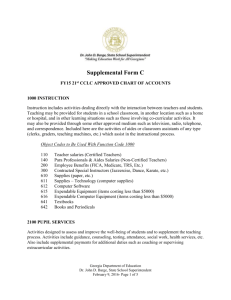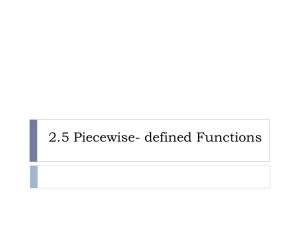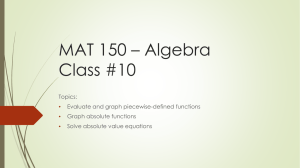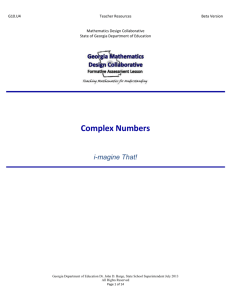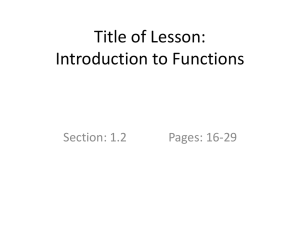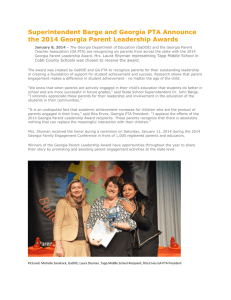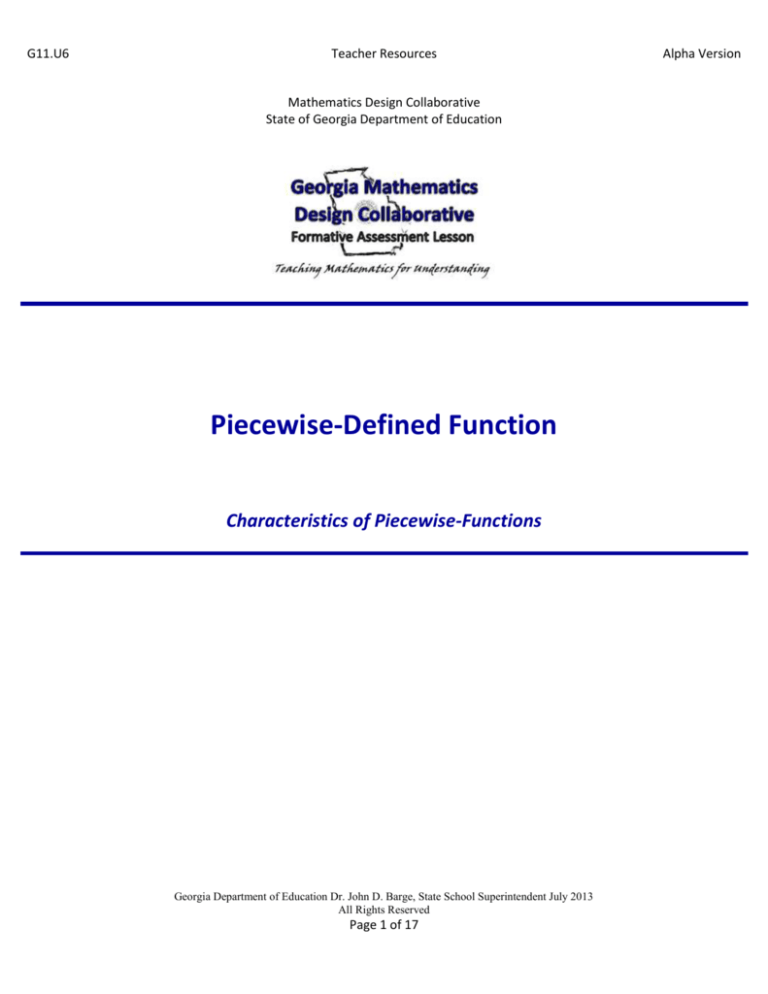
G11.U6
Teacher Resources
Mathematics Design Collaborative
State of Georgia Department of Education
Piecewise-Defined Function
Characteristics of Piecewise-Functions
Georgia Department of Education Dr. John D. Barge, State School Superintendent July 2013
All Rights Reserved
Page 1 of 17
Alpha Version
G11.U6
Teacher Resources
Alpha Version
INTRODUCTION TO THIS FORMATIVE ASSESSMENT LESSON
MATHEMATICAL GOALS
This lesson unit is intended to help you assess how well students are able to distinguish between and identify
characteristics of linear, quadratic, square root, step, absolute value, and piecewise-defined functions. In particular,
the lesson will help you identify and help students who have the following difficulties:
Understand how functions can be expressed in different forms, but remain equivalent.
Identify the characteristic that distinguishes the function family to which it belongs.
Describing the characteristics of piecewise-defined functions.
GEORGIA STANDARDS OF EXCELLENCE
This lesson involves mathematical content in the standards from across the grades, with emphasis on:
MGSE9-12.F.IF.7a Graph linear and quadratic functions and show intercepts, maxima, and minima (as
determined by the function or by context).
MGSE9-12.F.IF.7b Graph square root, cube root, and piecewise-defined functions, including step functions
and absolute value functions.
MGSE9-12.F.IF.8 Write a function defined by an expression in different but equivalent forms to reveal and
explain different properties of the function.
MGSE9-12.F.IF.9 Compare properties of two functions each represented in a different way
(algebraically, graphically, numerically in tables, or by verbal descriptions). For example, given a graph
of one function and an algebraic expression for another, say which has the larger maximum.
This lesson also relates to the following Standards for Mathematical Practice in the CCSS:
SMP 1. Make sense of problems and persevere in solving them.
SMP 2. Reason abstractly and quantitatively.
SMP 3. Construct viable arguments and critique the reasoning of others.
SMP 6. Attend to precision.
SMP 7. Look for and make use of structure.
SMP 8. Look for and express regularity in repeated reasoning.
INTRODUCTION
This lesson is structured in the following way:
Before the Lesson, students work individually on an assessment task that is designed to reveal their current
understandings and difficulties. You then review their work, and create questions for students to answer in order to
improve their solutions.
At the Start of the Lesson, after a whole-class interactive introduction, students work in groups on a collaborative task
in which they match graphs to the algebraic representations. As they do this, they begin to link different algebraic
forms of functions to particular properties of their graphs.
During the Lesson, students work in groups on a collaborative task in which they match graphs to the algebraic
representations. As they do this, they begin to link different algebraic forms of functions to particular properties of
their graphs.
After the Whole-Group Class Discussion, after a plenary discussion, students return to their original assessment tasks,
Georgia Department of Education Dr. John D. Barge, State School Superintendent July 2013
All Rights Reserved
Page 2 of 17
G11.U6
Teacher Resources
and try to improve their own responses.
Georgia Department of Education Dr. John D. Barge, State School Superintendent July 2013
All Rights Reserved
Page 3 of 17
Alpha Version
G11.U6
Teacher Resources
Alpha Version
MATERIALS REQUIRED
Each individual student will need:
Two copies of the assessment tasks. (One for pre-assessment and one for post-assessment)
Each small group of students will need:
One set of pre-cut Card Set A.
Final Graphs Paper
Extension group only – 5 index cards (If applicable)
The Teacher may need:
Document Camera (Optional)
TEACHER PREP REQUIRED
Teacher, be advised that prior to the lesson, the following preparations/copies will need to be made:
Precut Card Set A
TIME NEEDED:
For PreAssessment:
20 min.
For Lesson:
50 min.
For Post:
20 min.
Special Note(s) about timing: Allow 30 min of lesson for collaborative activity.
FRAMING FOR THE TEACHER:
Students will be asked to match graphs of piecewise-defined functions. Students will be “tricked” by these cards,
because the same functions are re-used from time to time, but with different pieces represented in the cards. The
answers have been coded so as to create words. This will allow a teacher to check correctness very quickly without
having to study students’ responses in the collaborative activity.
FRAMING FOR THE STUDENTS:
Say to the students:
This activity will take about _____1.5___days for us to complete.
The reason we are doing this is to be sure that you understand how to graph piecewise functions before we move on
to a new idea.
You will have a chance to work with a partner to correct any misconceptions that you may have. After the partner
work, you will be able to show me what you have learned!
Georgia Department of Education Dr. John D. Barge, State School Superintendent July 2013
All Rights Reserved
Page 4 of 17
G11.U6
Teacher Resources
Alpha Version
PRE-ASSESSMENT BEFORE THE LESSON
ASSESSMENT TASK:
Characteristics of Piecewise-Defined Functions
20 Minutes
Have the students do this task in class or for homework, a day or more before the
formative assessment lesson. This will give you an opportunity to assess the
work, and to find out the kinds of difficulties students have with it. You will then
be able to target your help more effectively in the follow-up lesson.
Give each student a copy of
Piecewise-Defined Functions
Briefly introduce the task and help the class to understand the problem and its
context.
Read through the task and try to answer it as carefully as you can.
Show all your work so that I can understand your reasoning.
It is important that students are allowed to answer the questions without your
assistance, as far as possible.
Students should not worry too much if they cannot understand or do everything,
because in the next lesson they will engage in a similar task, which should help them. Explain to students that by the end of the
next lesson, they should expect to be able to answer questions such as these confidently. This is their goal.
Assessing students’ responses
Collect students’ responses to the task. Make some notes on what their work reveals about their current levels of understanding,
and their different problem solving approaches.
We suggest that you do not score students’ work. The research shows that this will be counterproductive, as it will encourage
students to compare their scores, and will distract their attention from what they can do to improve their mathematics.
Instead, help students to make further progress by summarizing their difficulties as a series of questions. Some suggestions for
these are given on the next page. These have been drawn from common difficulties observed in trials of this unit.
We suggest that you write a list of your own questions, based on your students’ work, using the ideas that follow. You may
choose to write questions on each student’s work. If you do not have time to do this, select a few questions that will be of help to
the majority of students. These can be written on the board at the end of the lesson.
Have the students do this task in class or for homework, a day or more before the formative assessment lesson. This
will give you an opportunity to assess the work, and to find out the kinds of difficulties students have with it. You
will them be able to target your help more effectively in the follow-up lesson.
Georgia Department of Education Dr. John D. Barge, State School Superintendent July 2013
All Rights Reserved
Page 5 of 17
G11.U6
Teacher Resources
Alpha Version
COLLABORATION TIME/READING STUDENTS RESPONSES
You Will Not “Grade” These!
Collect students’ responses to the task. It is helpful to read students’ responses with colleagues who are also analyzing
student work. Make notes (on your own paper, not on their pre-assessment) about what their work reveals about their
current levels of understanding, and their approaches to the task. You will find that the misconceptions reveal
themselves and often take similar paths from one student to another and even from one teacher to another. Some
misconceptions seem to arise very organically in students’ thinking. Pair students in the same classes with other
students who have similar misconceptions. This will help you to address the issues in fewer steps, since they’ll be
together. (Note: pairs are better than larger groups for FAL’s because both must participate in order to discuss!)
You will begin to construct Socrates-style questions to try and elicit understanding from students. We suggest you
write a list of your own questions; however some guiding questions and prompts are also listed below as a jumpingoff point.
GUIDING QUESTIONS Here are some questions that you may find useful as you address misconceptions in class:
COMMON ISSUES
Student was unable to begin.
Student has misunderstanding of points of discontinuity.
Student makes incorrect assumptions about domain
restrictions.
Student correctly answers all the questions.
(The student needs an extension to the task.)
Student was unable to begin.
Student has misunderstanding of points of discontinuity.
Student makes incorrect assumptions about domain
restrictions.
SUGGESTED QUESTIONS AND PROMPTS
You are given a graph and an equation.
How many “pieces” does each algebraic representation
need?
What type of equation would be used to represent each
piece of the graph (linear, absolute value, quadratic, etc.)
What would the equation for those function families look
like?
What does an open circle mean or represent in an
inequality?
What does the closed circle represent?
Read the domain restrictions aloud and follow along by
tracing with your finger on the graph.
Have the students match the cards just as everyone else, but
then have them write a scenario that each piecewise-defined
function could represent.
You are given a graph and an equation.
How many “pieces” does each algebraic representation
need?
What type of equation would be used to represent each
piece of the graph (linear, absolute value, quadratic, etc.)
What would the equation for those function families look
like?
What does an open circle mean or represent in an
inequality?
What does the closed circle represent?
Read the domain restrictions aloud and follow along by
tracing with your finger on the graph.
Georgia Department of Education Dr. John D. Barge, State School Superintendent July 2013
All Rights Reserved
Page 6 of 17
G11.U6
Teacher Resources
Alpha Version
LESSON DAY
SUGGESTED LESSON OUTLINE:
Part 1: Whole-Class Introduction:
Time to Allot: ( 10 minutes)
Teacher writes student responses on the board while leading the discussion. Write the students’ names by their
contributions to the discussion as you write what they have said on the board.
Ask the class to discuss the characteristics of the function families mentioned and how they are able to distinguish
them from other function families. Also discuss characteristics of piecewise-defined functions.
Suggested Prompts:
What are the function families you covered thus far in this unit or that you remember from previous years?
What are the characteristics of those function families?
How are you able to distinguish one function family from other function families?
What is different/significant about piecewise –defined functions from other functions that are not piecewise-defined?
In what situation(s) would a piecewise-defined function be appropriate to describe a real-world situation?
Explain domain restrictions – what does this mean, graphically?
Part 2: Collaborative Activity: Grouping Card Set A
Time to Allot: (20 minutes)
Put students into their pairs according to your analysis of student errors.
Give each small group of students a pre-cut copy of Card Set A. Explain to the students that the aim is to match the
graph of each piece of the piecewise-defined function with the card that has its algebraic representation. After
matching each graph to the corresponding equation, have the students draw each piece of the piece wise functions on
one graph.
You may want to say:
Take turns matching pieces that you believe belong together.
Each time you do match pieces, explain your reasoning clearly and carefully to your group.
It is important that you both understand your matches. If you do not agree or understand ask your
partner to explain their reasoning. You both are responsible for each other’s learning.
The purpose of this structured group work is to encourage students to engage with each other's explanations and take
collaborative responsibility for understanding.
During the Collaborative Activity, the Teacher has 3 tasks:
Circulate to students’ whose errors you noted from the pre-assessment and support their reasoning with your
guiding questions.
Circulate to other students also to support their reason in the same way.
Make a note of student approaches for the summary (plenary discussion). Some students have interesting and
novel solutions!
Make a note of student approaches to the task.
Listen and watch students carefully. Note different student approaches to the task and any common mistakes. Also notice the
ways students check to see if their match is correct and how they explain and justify a match to each other. You can use this
information to focus a plenary whole-class discussion.
Georgia Department of Education Dr. John D. Barge, State School Superintendent July 2013
All Rights Reserved
Page 7 of 17
G11.U6
Support student reasoning.
Teacher Resources
Alpha Version
Try not to make suggestions that move students towards a particular match. Instead, ask questions to help students to
reason together.
If you find one student has produced a solution for a particular match, challenge another student in the group to provide
an explanation.
If you find students have difficulty articulating their decisions, then use the sheet Suggested questions and prompts to
support your own questioning of students.
If the whole class is struggling on the same issue, you could write a couple of questions on the board and hold an
interim, whole-class discussion. You could ask students who performed well in the assessment to help struggling
students.
During the small-group work, make a note of student approaches to the task, and to support student reasoning.
Part 3: PLENARY (SUMMARY) WHOLE-CLASS DISCUSSION
Time to Allot: (10 minutes)
After the students have had completed the collaborative activity with their groups have them share their processes and completed
graphs with the class.
Discussion prompts should be made up of your original guiding questions and notes about student approaches. Some
other discussion prompts are listed below:
NOTE: “Scribing” helps to increase student buy-in and participation. When a student answers your question, write
the student’s name on the board and scribe his/her response quickly. You will find that students volunteer more often
when they know you will scribe their responses – this practice will keep the discussions lively and active!
Encourage other students to challenge their explanations.
Allow students time to collaborate as much as possible.
Part 4: Improving Solutions to the Assessment
Task
Time to Allot: ( 20 minutes)
The Shell MAP Centre advises handing students their original assessment tasks back to guide their responses to their
new Post-Assessment (which is sometimes the exact same as the Pre-Assessment). In practice, some teachers find
that students mindlessly transfer incorrect answers from their Pre- to their Post-Assessment, assuming that no “X”
mark means that it must have been right. . Until students become accustomed to UNGRADED FORMATIVE
assessments, they may naturally do this. Teachers often report success by handing students a list of the guiding
questions to keep in mind while they improve their solutions.
Look at your original responses and think about what you have learned this lesson.
Using what you have learned, try to improve your work.
If you have not added questions to individual pieces of work then write your list of questions on the board.
Students should select from this list only the questions they think are appropriate to their own work.
They are to complete this post-assessment to the best of their ability without any prompts from the teacher.
Georgia Department of Education Dr. John D. Barge, State School Superintendent July 2013
All Rights Reserved
Page 8 of 17
G11.U6
Teacher Resources – Answer Documents
Alpha Version
PRE-ASSESSMENT (Answer Key)
ASSESSMENT TASK:
Characteristics of Piecewise Functions
Characteristics of Piecewise-Defined Functions
1. Write the algebraic representation for the given piecewise function graph.
2𝑥 + 10, 𝑥 < −2
𝑓(𝑥) = { 6, −2 ≤ 𝑥 ≤ 2
|𝑥| + 2, 𝑥 > 2
The answers here may vary. Some student may choose to write this piecewise-defined function
with 3 linear functions. They may also have differences in their domain restrictions. As long as their
domain restrictions do not over-lap they are correct.
2.
Graph the piecewise-defined function:
ƒ (x) =
Georgia Department of Education Dr. John D. Barge, State School Superintendent July 2013
All Rights Reserved
Page 9 of 17
G11.U6
Teacher Resources – Answer Documents
Alpha Version
Collaborative Activity (Answer Key)
CORRECT MATCHES FOR COLLABORATIVE ACTIVITY
The functions were matches so that they spelled several four-letter words…for instance, f(x) matches with A, C, and E, in that order. So the teacher can
quickly look at a student’s matches and know that if they see f, A, C, and E, that “F.A.C.E.” is in fact a correct matching of the three piecewise-defined
function.
The key words to remember for quick verification of matches are FACE, GORY, HITZ, KUBS, and PLUM.
Georgia Department of Education Dr. John D. Barge, State School Superintendent July 2013
All Rights Reserved
Page 10 of 17
G11.U6
Teacher Resources – Answer Documents
Completed Graphs (in order…FACE, GORY, HITZ, CUBS, and PLUM)
Georgia Department of Education Dr. John D. Barge, State School Superintendent July 2013
All Rights Reserved
Page 11 of 17
Alpha Version
G11.U6
Student Resources
Alpha Version
Card Set A
Z
O
U
C
I
E
R
T
A
Georgia Department of Education Dr. John D. Barge, State School Superintendent July 2013
All Rights Reserved
Page 12 of 17
G11.U6
Student Resources
Alpha Version
Y
M
B
S
U
L
(x + 1)2 ,
x ≤ −1
ƒ (x) = { 2,
−1<𝑥 ≤1
2x + 1,
x>1
2x + 1,
x ≤ −1
2
g (x) = { (x + 1) , −1 < 𝑥 ≤ 1
2,
x>1
−x + 4,
x < −1
−1≤ x ≤ 1
h(x) = { 2x + 1,
⃒𝑥 − 2⃒ + 2,
x > 1
2,
k(x) = { ⃒𝑥 − 4⃒, − 1 < 𝑥 ≤ 1
(𝑥 + 1)2 ,
x> 1
2x + 1,
x < −1
2
p (x) = { (x + 1) , −1 ≤ x < 1
⃒𝑥 − 2⃒ + 2,
x ≤ −1
x ≥ 1
Georgia Department of Education Dr. John D. Barge, State School Superintendent July 2013
All Rights Reserved
Page 13 of 17
G11.U6
Student Resources
Alpha Version
Final Graphs
(This sheet is provided if you would like students to graph entire piecewise functions on one page; using gridded chart paper as
an alternative is suggested. This allows students to display their work).
Georgia Department of Education Dr. John D. Barge, State School Superintendent July 2013
All Rights Reserved
Page 14 of 17
G11.U6
Projector Resources
Alpha Version
Lesson Day Warm-Up
In a pinball game, the ball rolls down a ramp, then is hit from beneath by a spring-loaded
hammer, which tosses the ball up into the air onto a horizontal “JACKPOT” bar. From there,
the ball rolls to the right, as sketched below.
1. How many different “parent function” shapes do you see in the path sketches?
2. What types of functions do you see (i.e. linear, quadratic, cubic, etc).
3. How could you find the equation for each of these paths?
Georgia Department of Education Dr. John D. Barge, State School Superintendent July 2013
All Rights Reserved
Page 15 of 17
G11.U6
Projector Resources
Alpha Version
Collaborative Activity Instructions:
You have been paired into groups based upon your responses on the
Pre-Assessment you were given.
Your goal is to match the graph of each piece of the piecewisedefined function with the card that has its algebraic representation.
After matching the three you believe belong together, draw the total
graph on the grids provided for you.
Take turns matching pieces that you believe belong together. Each
time you do match pieces, explain your reasoning clearly and carefully
to your group.
It is important that you both understand your matches. If you do not
agree or understand ask your partner to explain their reasoning. You
both are responsible for each other’s learning.
Georgia Department of Education Dr. John D. Barge, State School Superintendent July 2013
All Rights Reserved
Page 16 of 17
G11.U6
Projector Resources
Alpha Version
Collaborative Plenary Discussion Questions:
You are given a graph and an equation.
How many “pieces” does each algebraic representation need?
What type of equation would be used to represent each piece of
the graph?
What would the equation for those function families look like?
What does an open circle mean or represent in an inequality?
What does the closed circle represent?
Read the domain restrictions aloud and follow along by tracing
with your finger on the graph.
Georgia Department of Education Dr. John D. Barge, State School Superintendent July 2013
All Rights Reserved
Page 17 of 17

